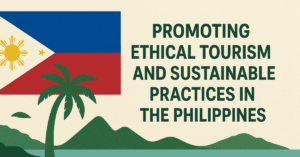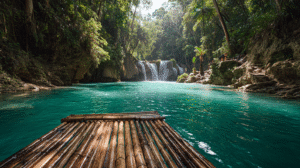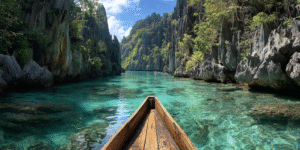More Than Just Chocolate Hills: A Traveler’s Guide to Bohol
Did you know that Bohol is home to an estimated 1,776 conical hills, yet none of them are man-made? This geological marvel is a great starting point, but Bohol’s appeal runs much deeper, splitting its personality between the lush, rolling landscapes of the mainland and the vibrant coastal energy of Panglao Island. Whether you’re here for world-class diving or a quiet encounter with the world’s smallest primate, a thoughtful Bohol travel guide is essential to navigating its diverse offerings. This isn’t just a list; it’s a strategy for experiencing the island’s best.
Nature and Wildlife Encounters
The iconic Chocolate Hills are, without a doubt, a must-see. These unique limestone formations, the result of uplifting coral deposits and erosion, transform into a rich brown color during the dry season (late November to May), resembling giant chocolate kisses. For the best panoramic views, head to the government-run complex in Carmen. The entrance fee is around PHP 100 (less than $2 USD). A word of advice: visit on a clear weekday morning to avoid the biggest crowds.
Equally famous but far more delicate is the Philippine Tarsier. To see this creature ethically, you must visit the Philippine Tarsier Sanctuary in Corella. This is not a zoo, but a protected forest habitat managed by the Philippine Tarsier Foundation. The tarsiers are nocturnal and incredibly sensitive to stress, so visitors are required to stay on the designated path, maintain silence, and strictly avoid flash photography. The experience is a quiet, respectful walk through the forest, hoping for a glimpse of the tiny primate. Seeing one in a semi-wild environment is one of the most memorable things to do in Bohol.
Cultural and Historical Stops
Bohol’s history is deeply etched into its architecture. The Church of Our Lady of the Immaculate Conception in Baclayon is one of the oldest coral stone churches in the region, with its original structure dating back to 1727. The church was significantly damaged during the 2013 earthquake, and its painstaking restoration has become part of its living history. A small museum on-site houses centuries-old religious artifacts.
For a quick history lesson, stop at the Blood Compact Shrine in Tagbilaran. The monument commemorates the 1565 Sandugo (blood compact) between Spanish explorer Miguel López de Legazpi and Datu Sikatuna, a local chieftain. It symbolizes the first treaty of friendship between Filipinos and Spaniards and is a brief but important stop on any countryside tour.
Local Flavors and Riverside Views
The Loboc River Cruise is one of the most popular tourist attractions in Bohol for a reason. You’ll board a floating restaurant for a gentle cruise down a jungle-fringed river while enjoying a buffet of Filipino food. The cost, around PHP 850 ($15 USD) per person, includes the meal and a short cultural performance by a local community along the bank. While tourist-focused, it’s a relaxing way to spend a midday hour. For a more direct taste of local life, visit the Tagbilaran Central Market. Here you can find local delicacies like calamay (a sticky, sweet treat served in a coconut shell), peanut kisses, and fresh produce.
Adventure and Coastal Activities
Panglao Island, connected to the mainland by two bridges, is Bohol’s hub for sun and sea. Alona Beach is the busiest strip, lined with dive shops, restaurants, and hotels. It’s the primary jumping-off point for island-hopping tours to Balicasag Island, a marine sanctuary famous for its sea turtle population, and Pamilacan Island, known for dolphin watching.
If you’re looking for what to do in Bohol beyond the standard tours, consider renting a stand-up paddleboard for a quiet journey up the Loboc or Abatan River. This offers a more intimate and active alternative to the lunch cruise, allowing you to appreciate the mangrove forests and nipa palms at your own pace. For the truly adventurous, head east to Anda and seek out the Cabagnow Cave Pool. This deep, stunning cenote is a natural swimming hole for confident swimmers looking for a thrill.
Beyond the Main Tourist Trail
If the crowds of Panglao feel overwhelming, make the two-hour drive to Anda. This quiet municipality on Bohol’s eastern coast boasts a long, pristine stretch of white sand beach that rivals anything on Panglao but with a fraction of the visitors. The atmosphere is laid-back, the accommodations are more boutique, and it serves as a great base for exploring the area’s cave pools and the Cadapdapan Rice Terraces in Candijay—a beautiful, lesser-known agricultural landscape.
Practical Travel Tips for Bohol
Understanding the logistics will make your trip smoother. Here are a few essential tips:
- Getting Around: For mainland tours of the Chocolate Hills and tarsiers, hiring a private car and driver for the day is most efficient (PHP 2,500-3,500 / $45-60 USD). On Panglao, renting a scooter (PHP 300-500 / $5-9 USD per day) offers the most freedom. Tricycles are available for shorter distances.
- Best Time to Visit: The dry season from December to May is ideal for beach activities and seeing the hills turn brown. The wet season (June to November) means greener landscapes and fewer tourists, but be prepared for rain.
- Getting There: The Bohol-Panglao International Airport (TAG) receives domestic flights from Manila and other hubs. Alternatively, fast ferries from Cebu City to Tagbilaran are frequent and take about two hours.
- Connectivity: Purchase a local SIM card (Globe or Smart) upon arrival for reliable data. Wi-Fi can be inconsistent, especially outside of major resorts.
Bohol presents a choice. You can follow the well-trodden path of a countryside tour or rent a motorbike and find the quiet coves of Anda. You can join the vibrant crowds on Alona Beach or seek a quiet moment on the Loboc River. The best list of things to do in Bohol is the one you create for yourself, balancing the island’s famous sights with its quieter, more personal moments.




